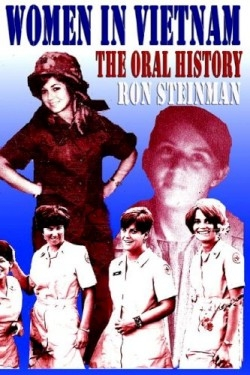
Women in Vietnam
The Oral History
Although there are countless films, books, documentaries, and oral accounts of the male experience in the Vietnam War, there is little or nothing about the approximately 7,500 women who served in South Vietnam. The United States Government, the general public, and even the veterans themselves are responsible for this lack of recognition. The time for anonymity has ended. With the help of the Women’s Vietnam Memorial Project and documentarians like Ron Steinman, these women will get the recognition and public honor they deserve.
Ron Steinman was a journalist and bureau chief with NBC in Vietnam from 1966-1971 and witnessed the work of many women on the front lines. Perplexed that these women went without recognition, Steinman, author of The Soldier’s Story: Vietnam in Their Own Words, produced a documentary for The Learning Channel about the Women’s Vietnam Memorial Project, a statue that would memorialize women who served in any capacity during the war. The television program was limited by time, so Steinman had the women’s entire interviews transcribed for this collection. It is an account of survival and service, told in their own words.
The interviews cover all types of service that women were involved in: from nurses to army administration to Red Cross volunteers. No matter what area, each woman shared similar experiences with the Vietnamese people, with the soldiers they cared for, and with the community that they returned to.
Lily Jean Adams, an army nurse stationed in the 12th Evacuation Hospital in Cu Chi, was exposed to Agent Orange during her service. Out of all the destruction she describes, her only regret is that she feels she has created in her children “a genetic time bomb,” and she can discuss her medical difficulties only with military doctors.
While nurses saw most of the carnage, others were not immune. Marilyn Roth, a member of the Women’s Army Corps, felt the women and men in Vietnam were “like brothers and sisters.” Many women noted that men were grateful to see them. They were representatives of someone’s wife, mother, sister, or daughter—sometimes at the moment of death.
Air Force Flight Nurse Jackie Knoll, who served in the Phillipines, described holding a young man in her arms that had been severely wounded and sympathized with him. She knew he was “worried about going back and facing family, friends and those who were used to him as he was before. He was worried that he might not be accepted by others.”
Susan Bradshaw McLean, a twenty-two-year-old Red Cross Donut Dolly in Qui Nhon, now teaches and discusses Vietnam in her classroom because she wants to “pass along what happened.” She, like many of the women who were not military, want the truth to be known because, as she says, they get “no recognition for their role in Vietnam, no medical benefits and… not even a flag to cover [their] coffin when [they] die.”
The public was and is still incredulous that women served in Vietnam. The U.S. Government aided in this denial by designating many females as male, in their records. Nevertheless, these women were called to service and were volunteers. Most of them suffer from some form of post-traumatic stress disorder, if not physical ailments, due to their experiences. Their healing process will be long, just as any veteran’s is, but it starts with recognition. (August 2000)
Reviewed by
Kristin Putchinksi
Disclosure: This article is not an endorsement, but a review. The publisher of this book provided free copies of the book to have their book reviewed by a professional reviewer. No fee was paid by the publisher for this review. Foreword Reviews only recommends books that we love. Foreword Magazine, Inc. is disclosing this in accordance with the Federal Trade Commission’s 16 CFR, Part 255.
